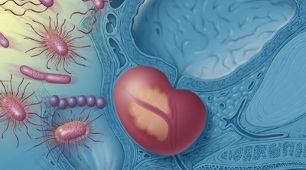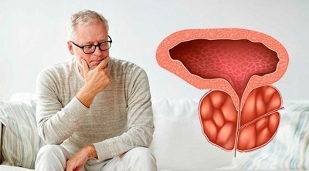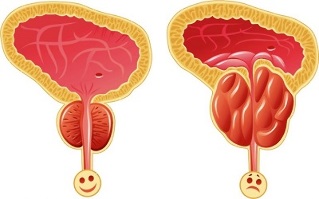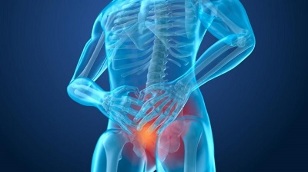
Description of the causes, symptoms, features of diagnosis and treatment of acute or chronic bacterial prostatitis. Recommendations from urologists who will help you quickly identify the disease and contact the clinic in time for diagnosis and description of complex therapy.
Prostatitis is one of the most common urological diseases in men. Inflammation of the prostate brings troubles in life and can lead to sexual weakness.
According to various estimates, from a quarter to a third of the male population after 40 years experience prostate problems, in young people the statistics are better, but still unsatisfied.
Today we will talk about bacterial prostatitis (BP), we will examine the causes of its occurrence, symptoms and features of diagnosis and treatment.
Causes of occurrence
The difficulty with PD is that it often develops in a subtle form and is not detected for a long time, which delays the start of treatment.
The leading cause of bacterial prostate type inflammation is glandular infection, but not only this leads to disease.
Among the causes of bacterial prostatitis, we note:
- Sedentary lifestyle.
- Breaking the rhythm in sex life.
- Mbipesha.
- Chronic constipation.
- Alcohol abuse.
To understand how these causes affect the onset and development of pathology, let us consider their specifics.
Germs and infections enter the prostate regularly, but this does not always lead to bacterial infection, as the immune system is working.
In addition, good blood flow quickly carries infections and stimulates local immunity in the gland area, which prevents infection.
Interesting!With a sedentary lifestyle and irregular sex, an overload forms in the prostate, which is an additional factor in the onset of the disease.
If you have a sedentary job, then after 40, and even earlier, it is a good idea to go to the gym or do hip exercises at home.
Also overweight and chronic constipation interfere with blood flow to the gland area. Keep track of your body weight and include high-fiber foods in your diet to prevent constipation.
As for alcohol, it weakens the immune system (with regular abuse), which removes the body's protective barrier and is easier for germs to "gain a foot" in the prostate.
Remember, bacteriological prostatitis does not arise from scratch, most often the disease occurs in those who do not monitor their health.
Symptoms of the disease
Like any other disease, PD has its own symptoms, the severity of which varies with the stage of the disease and the characteristics of the patient's body.
Most often a person with prostate inflammation worries about:
- Frequent urination.
- Painful sensations when going to the toilet.
- Weight in the groin area.
- Reduction of the sexual machine, up to erection problems.
The most pronounced symptoms are when acute PD develops, if treatment is not started, then the disease becomes chronic and the severity of symptoms subsides.
There is no need to rejoice here, as chronic inflammation is more difficult to treat and therapy takes more time.
Bacteria that cause prostatitis are microplasmas, chlamydia, and other germs that can enter the prostate through urine or through the bloodstream from an infected primary organ.Important!If you have the first symptoms of prostatitis, then this is a reason to go to the urologist and get diagnosed, because a quick start of treatment increases the chances of success.
Acute prostatitis
In the acute form, the patient may also have a rise in temperature of up to 40 degrees, as well as the appearance of fever. Pain in the groin can be sharp, purulent discharge appears from the urethra and the desire to use the toilet is very common.

Acute bacterial prostatitis in men can not go unnoticed, this is its advantage, as the patient immediately goes to the urologist.
In the acute form, there is a strong burning sensation during the visit to the toilet and general irritability and fatigue appear.
If therapy is not started on time, PD can lead to complications:
- An abscess in the body of the prostate.
- Vesicles.
- Coliculitis.
- Cicatricial changes in the prostate gland.
An abscess, on the other hand, can lead to prostate rupture and severe intoxication of the body, and with vesicles, pus appears in the semen and a man's reproductive function may end.
Coliculitis is no less dangerous, in which a strong pain syndrome develops during sex, which can lead to psychological trauma and impotence.
Scar changes lead to infertility as it reduces sperm motility and sperm quality. In addition, narrowing of the urethra with scars makes urination difficult and leads to bladder blockage, which may be the reason for the surgeon’s intervention.
Chronic form
Chronic bacterial prostatitis is either primary or secondary. In the first case, it develops immediately without an acute phase, in the second it arises as an advanced form of acute prostate inflammation.
The symptoms of the chronic phase are more vague, but they also give the patient concerns:
- Difficulty urinating.
- The desire to use the toilet is growing.
- Erectile function is impaired.
- A burning sensation and heaviness is felt in the perineal region.
These are the main signs of chronic PD, if treatment does not start on time (complex therapy), then complications are possible in the form:
- Cystitis.
- Sepsis.
- Pyelonephritis.
- Decreased immunity.
The risk of the disease is precisely in the less pronounced symptoms, which sometimes men simply do not pay attention to.
If it is impossible not to notice the acute phase, then the chronic inflammatory process is often ignored and treatment is long and not always effective.
Diagnosis of inflammation

When the first signs of prostatitis appear, you should go to the doctor who will prescribe a series of diagnostic measures. They will make it possible to determine the presence of inflammation and its type, which will help in the effective treatment of the disease.
Complete diagnosis includes:
- Digital examination of the prostate gland.
- Analysis of prostate secretion.
- Getting tainted for sexually transmitted diseases.
- Ultrasound of the gland.
Your doctor may also order a semen test and biopsy to rule out or confirm the presence of prostate cancer.
Digital examination of the gland is an uncomfortable but important stage of diagnosis, as the patient is simple, has an uneven density, and is enlarged in size.
Secretion analysis will determine the infectious or non-infectious form of the disease and ultrasound will help the doctor see the contours of the gland - if they are blurred, then this is a clear confirmation of prostatitis.
After the diagnosis, the urologist decides on the treatment of the patient, taking into account:
- Type of prostatitis.
- Form of the disease.
- Age of the patient.
- Individual patient characteristics.
- Presence of concomitant diseases.
Accurate diagnosis allows you to choose the optimal treatment regimen and therapy shows the maximum effect. The more stages the diagnosis requires, the more accurate the diagnosis will be and the easier it will be to prescribe a complex therapy.
Treatment of prostate inflammation
Therapy for acute and chronic bacterial prostatitis is different, as it requires different doses of medication and varies in the duration of treatment.
Interesting!In the initial stage, it is important to eliminate the unpleasant symptoms for the patient in order to improve the quality of life, as the doctor's task is to completely get rid of the disease, regardless of its form.
Acute Prostate Therapy

In the treatment of acute prostatitis, etiotropic therapy is necessarily prescribed; in the case of a bacterial type of disease, it cannot be done without taking antibiotics and antimicrobial agents.
Furthermore, the following are specified:
- Pain reliever.
- Immunostimulants.
- Vitamins with trace elements.
- Massage.
Important! Antibiotics and antibacterial agents fight germs, while vitamins and immunostimulants help boost immunity.
Massage during the pre-acute phase accelerates the secretion of prostate secretions and normalizes blood flow to the gland.
In the event of an acute course of the disease, massage cannot be prescribed, and physiotherapeutic procedures, such as laser and electrophoresis, are not recommended at this stage.
They are a mandatory phase of treatment, but are not recommended in the acute phase of PD.
Chronic Therapy for Prostatitis
Treatment of chronic bacterial prostatitis requires longer therapy and an expanded range of procedures. An increase in the dose of medication is often required.
Added in the above stages of treatment:
- Reception of phytopreparations.
- A full range of physiotherapy.
- Perform special exercises.
- Consultation with a psychologist.
With a decrease in potency, increased doses of vitamins and stimulants may be prescribed, as treatment requires regular sexual activity.
As for the exercises, they are chosen depending on age, disease course and individual characteristics of the organism. Also, the doctor takes into account the presence of side diseases.
From the article you learned how to diagnose bacterial prostatitis, then you just need to carefully monitor your health and consult a doctor when the first signs of the disease appear.
The sooner therapy begins, the shorter the treatment process will be and the sooner the man will return to a full life.
























